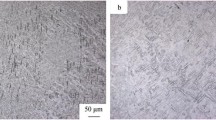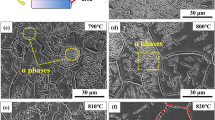Abstract
First principles plane wave pseudopotential method was executed to calculate the mechanical properties with respect to the uranium-0.95 mass fraction of titanium (U-0.95 mass fraction of Ti) alloy for quenching and aging, including the elastic modulus, the value of shear modulus to bulk modulus (G/B) and the ideal tensile strength. The further research has also been done about the crack mechanism through Griffith rupture energy. These results show that the elastic moduli are 195.1 GPa for quenching orthorhombic α´ phase and 201.8 GPa for aging formed Guinier-Preston (G.P) zones, while G/B values are 0.67 and 0.56, respectively. With the phase change of uranium-titanium (U-Ti) alloy via the quenching treatment, the ideal tensile strength is diverse and distinct with different crystal orientations of the anisotropic α´ phase. Comparison of quenching and short time aging treatment, both of the strength and toughness trend to improve slightly. Further analysis about electronic density of states (DOS) in the electronic scale indicates that the strength increases continuously while toughness decreases with the aging proceeding. The equilibrium structure appears in overaging process, as a result of decomposition of metastable quenching α´ phase. Thereby the strength and toughness trend to decrease slightly. Finally, the ideal fracture energies of G.P zones and overaging structure are obtained within the framework of Griffith fracture theory, which are 4.67 J/m2 and 3.83 J/m2, respectively. These results theoretically demonstrate strengthening effect of quenching and aging heat treatment on U-Ti alloy.









Similar content being viewed by others
References
Baschwitz R, Colombie M, Foure M (1968) Etude du revenue des phases orthorhombiques metastables d’all-iages uranium-titane tetrant 4, 8 et 9, 5 at% de titane. J Nucl Mater 28:246–256
Federer JI (1969) Effect of alloy additions and heat treatments on the mechanical properties of U-0.5Ti alloy. U. S. Atomic Energy Commission Contract Report, Tenn, Report No. ORNL-TM-2482
Harding AG, Waldron MB (1958) Transformation in uranium alloys with high solute solubility in the B. C. C. gamma phase, part I. Preliminary observations on the “banded structure” produced by non equilibrium transformations in uranium alloys. Atomic Energy Research Establishment, Harwell, Report No. AERE-M/R-2673
Anagnostides M, Colombie M, Monti H (1964) Metastable phase in the alloys uranium-niobium. J Nucl Mater 11:67–76
Douglass DL (1961) The structure and mechanical properties of uranium-titanium martensites. Trans ASM 53:307–319
Anagnostidis M, Baschwitz R, Colombie M (1966) Phase metastables dans les alliages uranium-titane. Mem Sci Rev Met 63:163–168
Speer JG, Edmonds DV (1999) Aging of α ’a martensite in U-0.77Ti. Acta Mater 47(7):2197–2205
Yakel HL (1969) A Fortran-language program for plotting stereographic projections of lattice plane normals and directions. U. S. Atomic Energy Commission Contract Report, Tenn, Report No. W-7405-ENG-26
Hatt BA, Roberts JA (1960) The ω-phase in zirconium base alloys. Acta Mater 8:575–584
Hatt BA (1966) The orientation relationship between the gamma and alpha structures in uranium-zirconium alloys. J Nucl Mater 19:133–141
Stelly M (1972) Precipitation isotherme dans des alliages d’uranium-cinetique de precipitation. Commissariat a l’Energie, Atomique, Centre d’Etudes Nucleaires, Saclay, Report No. CEA-R-4326
Skriver HL, Andersen OK, Johansson B (1978) Calculated bulk properties of the actinide metals. Phys Rev Lett 41:42–45
Wills JM, Eriksson O (1992) Crystal structure stabilities and electronic structure for the light actinides Th, Pa and U. Phys Rev B 45:13879–13890
Söderlind P, Eriksson O, Johansson B et al (1994) Electronic properties of f-electron metals using the generalized gradient approximation. Phys Rev B 50:7291–7294
Söderlind P (2002) First-principles elastic and structural properties of uranium metal. Phys Rev B 66:085113
Hohenberg PC, Kohn W (1964) Inhomogeneous electron gas. Phys Rev 136:B864–B871
Kohn W, Sham LJ (1965) Self-consistent equations including exchange and correlation effects. Phys Rev 140:A1133–A1138
Kresse G, Furthmuller J (1996) Efficient iterative schemes for ab initio total-energy calculations using a plane-wave basis set. Phys Rev B 54(16):11169–11186
Perdew JP, Burke K, Ernzerhof M (1996) Generalized gradient approximation made simple. Phys Rev Lett 77:3865–3868
Vanderbilt D (1990) Soft self-consistent pseudopotentials in a generalized eigenvalue formalism. Phys Rev B 41:7892–7895
Hill R (1952) The elastic behaviour of a crystalline aggregate. Proc Phys Soc 65:349–354
Monkhorst HJ, Pack JD (1976) Special points for Brillouin-zone integrations. Phys Rev B 13:5188–5192
Krenn CR, Roundy D, Morris JW (2001) Ideal strengths of bcc metals. Mater Sci Eng A 319–321:111–114
Clatterbuck DM, Chrzan DC, Morris JW (2003) The ideal strength of iron in tension and shear. Acta Mater 51:2271–2283
Chatterjee A, Niwa S, Mizukami F (2005) Structure and property correlation for Ag deposition on α-Al2O3: a first principle study. J Mol Graphics Model 23:447–456
Gong HR (2009) Electronic structure and related properties of Pd/TiAl membranes. Intermetallics 17:562–567
Acknowledgments
Computational resources were supported by Shanghai Supercomputer Center and High Performance Computing Center, Shanghai University. The work described in this paper was supported by the National Natural Science Foundation of China (Grant Nos. 51074103 and 51104098) and Shanghai Scientific Selection and Cultivation for outstanding young teachers in special fund and Innovation Program of Shanghai University (Grant No. SDCX2012011).
Author information
Authors and Affiliations
Corresponding author
Rights and permissions
About this article
Cite this article
Qi, JB., Wu, GX. & Zhang, JY. Mechanical properties of U-0.95 mass fraction of Ti alloy quenching and aging treatment: a first principles study. Adv. Manuf. 3, 244–251 (2015). https://doi.org/10.1007/s40436-014-0090-1
Received:
Accepted:
Published:
Issue Date:
DOI: https://doi.org/10.1007/s40436-014-0090-1




